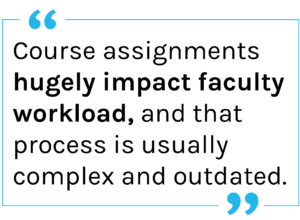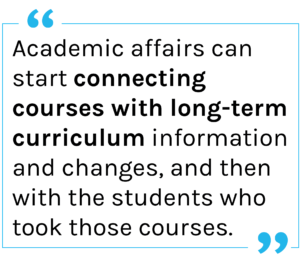Balancing faculty workloads has an impact on more than just a faculty member’s day-to-day.
day-to-day.
When administrators ensures that faculty have equitable and balanced workloads, taking every aspect of their roles into account, it can have a wider impact on your institution. Beyond preventing faculty burnout, ensuring balanced workload can have a positive impact on the student. Read on to learn more about the importance of balancing faculty workloads.
Burnout isn’t going away
Faculty burnout is still on the radar – and it likely will be on the minds of HigherEd professionals for a long time. Burnout has been a hot topic in every industry since 2020, starting with work-life balance during the pandemic, then transitioning into the great resignation, and now with “quiet quitting” (or not going above and beyond for your job), all of which have been responses to workers across the country feeling overworked, overwhelmed and—of course—burnt out. We know what employees are doing, but what can employers do to support the faculty and staff who are feeling burned out—or to prevent burnout in the first place?
Addressing the Faculty Balancing Act
It’s a balancing act, especially when it comes to faculty. Their workloads are complex and include teaching, course preparation, advising students, research, writing, service roles, leadership roles, and administrative work. Balancing that workload isn’t just the responsibility of the faculty member. Service work, for instance, is often taken on because a faculty member was specifically asked to do so—often, without taking into account the rest of their workloads (and there are some equity issues at play with service work too—check out this blog post for more).
 Course assignments also hugely impact faculty workload, and that process is usually complex and outdated. With systems that don’t take a faculty member’s entire role into account, some end up over-scheduled thanks to under-the-radar committee or leadership work. This kind of over-scheduling contributes to burnout because of heavier workload, and contributes to a lack of transparency and trust between faculty and administrators.
Course assignments also hugely impact faculty workload, and that process is usually complex and outdated. With systems that don’t take a faculty member’s entire role into account, some end up over-scheduled thanks to under-the-radar committee or leadership work. This kind of over-scheduling contributes to burnout because of heavier workload, and contributes to a lack of transparency and trust between faculty and administrators.
If your institution is focused on retention, this is a great place to start. Digitization is key to tackling the problem of workload balance. Centralizing all faculty information—including service and leadership commitments, as well as research—means that both faculty and academic affairs have a comprehensive view of workload. With a new collaboration with a teaching assignment management tool, PeopleAdmin is committed to connecting all of that workload information to the course assignment process, offering an end-to-end faculty solution that mitigates faculty burnout.
Student outcomes are the bottom line
The central mission of higher education institutions is student success—and faculty have a huge impact on student success. Shepherding students from orientation all the way through graduation is a team effort, but professors in particular have a huge impact on student retention rates. Ensuring that faculty have balanced workloads—meaning they have time to work individually with students on research and advising—is part of ensuring they can contribute to a culture of student success and retention.
Digitization is also a starting point here—connecting faculty activity with student outcomes requires a centralized system. If every course that a faculty member has taught over the years is in one system, academic affairs can start connecting those courses with long-term curriculum information and changes, and then with individual students who took the courses. From there, you can examine student outcomes and connect it all back to individual professors. With the right system, your team can even tie in course evaluations to understand curricular effectiveness.
a faculty member has taught over the years is in one system, academic affairs can start connecting those courses with long-term curriculum information and changes, and then with individual students who took the courses. From there, you can examine student outcomes and connect it all back to individual professors. With the right system, your team can even tie in course evaluations to understand curricular effectiveness.
Final thoughts
Faculty members are woven through the entire ecosystem of your campus. They are integral to the ensuring that courses keep running and students learn what they need to graduate successfully. That’s why keeping track of their workloads should be at the top of the list for every institution. If you haven’t started tackling faculty digitization, now is the time! Reach out to PeopleAdmin experts for more.